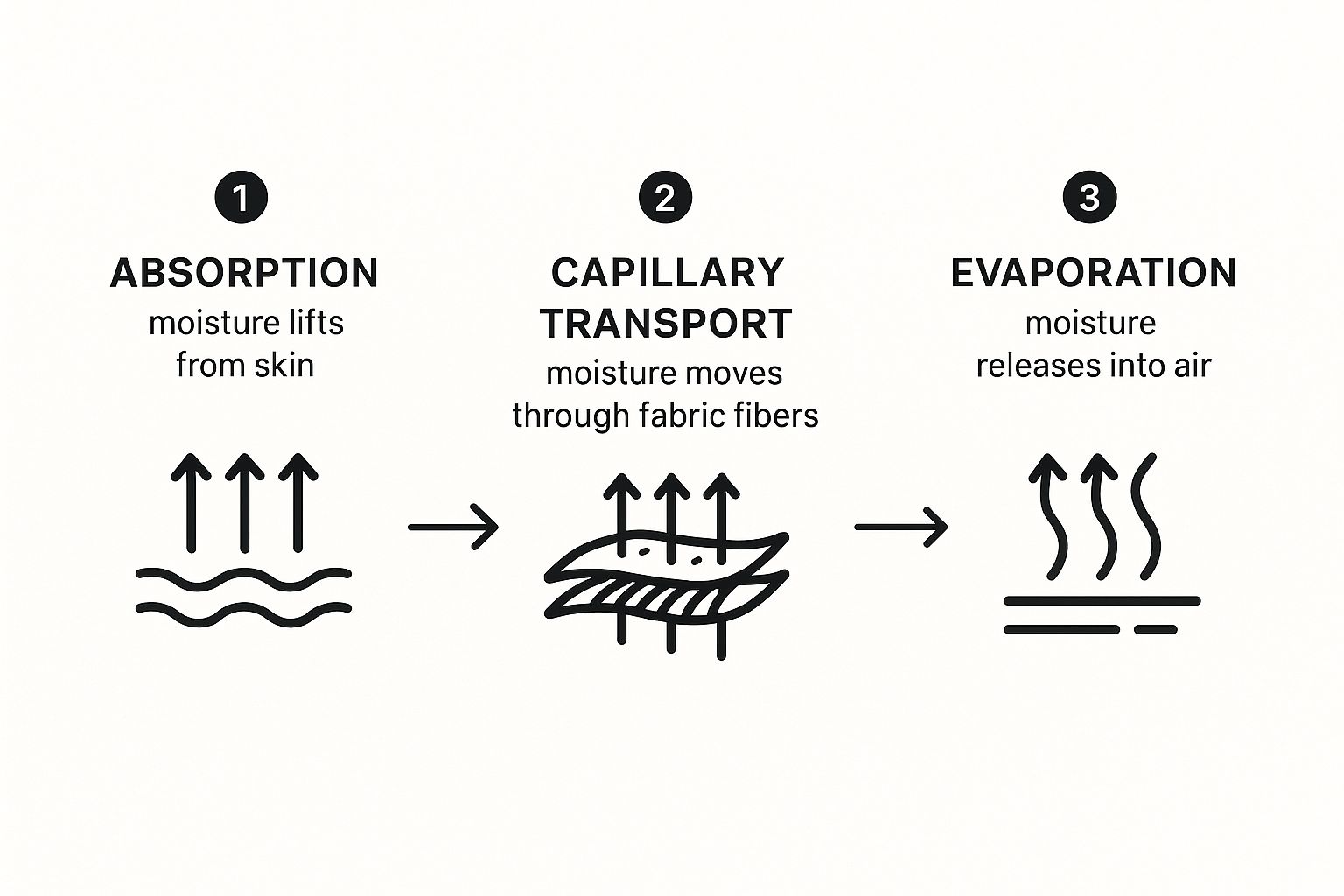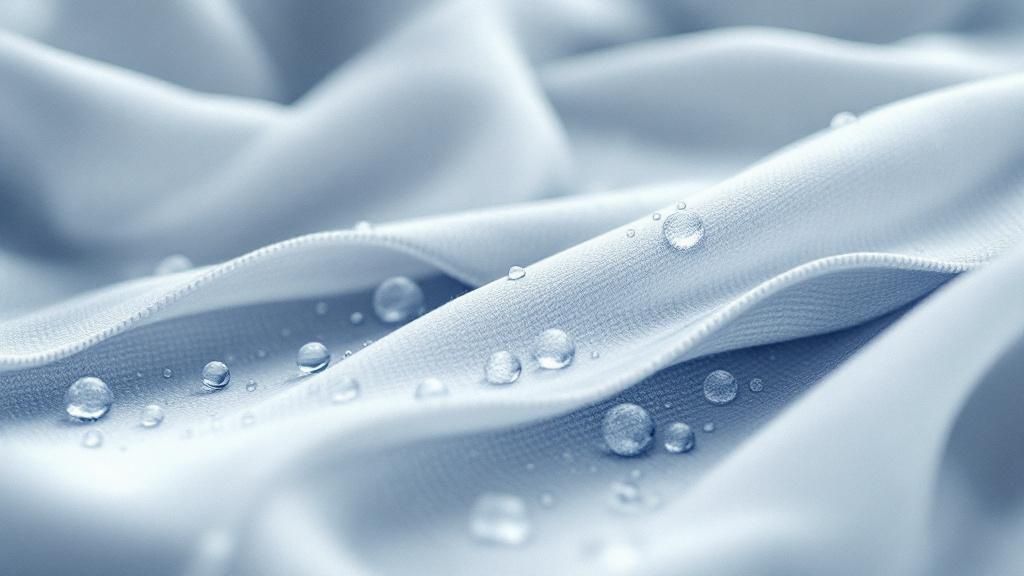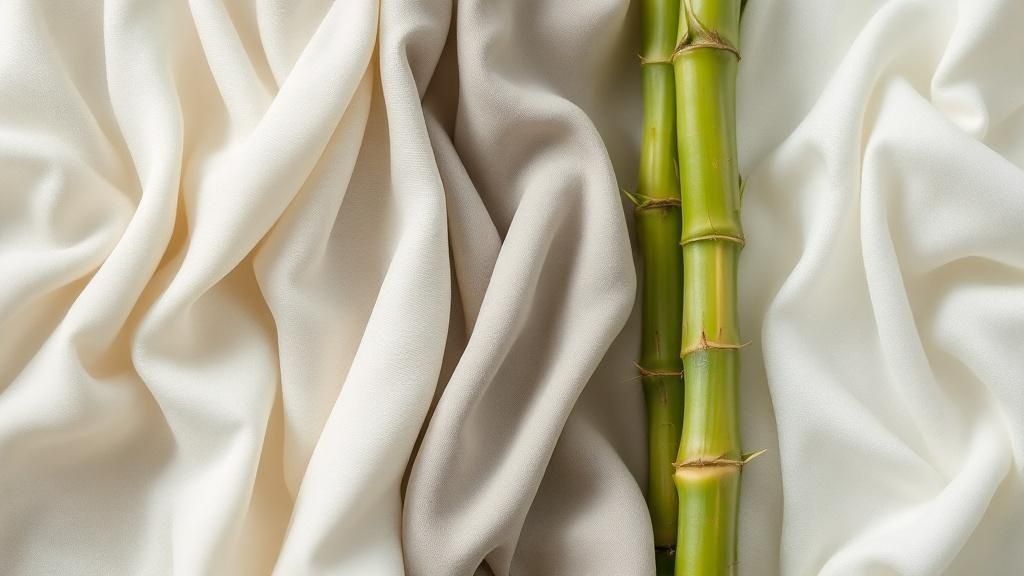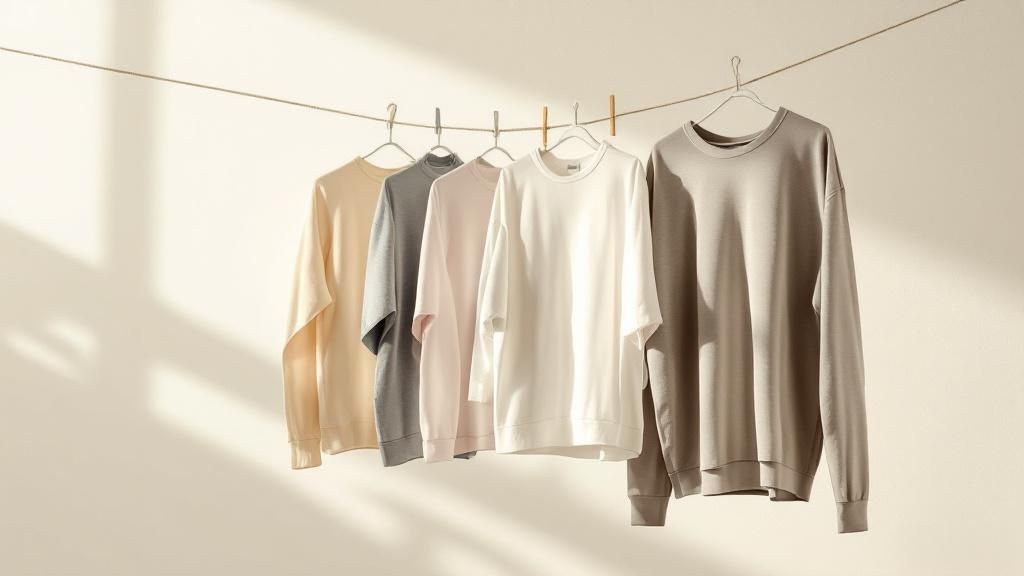Ever wondered how some athletic gear keeps you feeling so dry, even during a tough workout? The secret is in the fabric. A moisture-wicking fabric is a type of smart textile specifically engineered to pull sweat away from your skin.
Instead of just soaking up moisture like a regular cotton shirt, it acts more like a high-tech pipeline. It moves sweat to the outer surface of the garment where it can evaporate quickly, keeping you dry and comfortable no matter what you're doing.
The Science Behind Staying Dry: How Wicking Fabric Works
So, how does it actually work? The magic of moisture-wicking fabric lies in a clever two-part process. It's not just about absorbing sweat; it's about actively managing it to keep you comfortable.
First, the fabric has to get the moisture off your skin. It does this through a process called capillary action, which you might remember from science class. Think about how a paper towel soaks up a spill—the liquid seems to climb right into it. The tiny, tight-knit fibers in wicking fabrics do the exact same thing with your sweat, drawing it away from your body and into the material.
This simple graphic shows exactly how moisture travels from your skin to the air.

As you can see, the fabric's structure is key. It lifts sweat, pulls it through the material, and then releases it. This all happens incredibly fast, which is why you feel so much drier, even when you're working up a sweat.
From Movement to Evaporation
Once the sweat reaches the outer surface of the fabric, the second part of the process kicks in: evaporation. By spreading the moisture out over a much larger surface area, the fabric helps it turn into vapor and disappear into the air far more quickly. This is where wicking fabrics really shine compared to absorbent ones.
A standard cotton t-shirt can absorb up to 7% of its weight in moisture, quickly becoming heavy, saturated, and cold. In stark contrast, a high-performance polyester fabric holds only about 0.4%, forcing moisture to evaporate instead of linger.
This rapid evaporation is what prevents that cold, clammy feeling you get when you stop moving after exercising in a wet shirt. Wicking fabrics are constantly working to keep you comfortable, which is why they're such a game-changer for athletes and anyone looking for all-day comfort.
Wicking vs Absorbent Fabrics At a Glance
To put it all into perspective, let's compare moisture-wicking fabrics directly with traditional absorbent materials like cotton. This table breaks down the key differences.
| Feature | Moisture-Wicking Fabric (e.g., Polyester) | Absorbent Fabric (e.g., Cotton) |
|---|---|---|
| Moisture Handling | Pulls sweat from skin to the surface for evaporation | Soaks up and holds onto moisture like a sponge |
| Drying Speed | Dries very quickly | Dries very slowly, especially when saturated |
| Comfort During Activity | Stays lightweight and dry, preventing chafing | Becomes heavy, wet, and can cause chafing |
| Temperature Regulation | Helps cool the body through efficient evaporation | Can make you feel cold and clammy once you stop moving |
| Best For | High-intensity workouts, hot weather, activewear | Casual wear, low-sweat activities, everyday comfort |
As you can see, the choice really depends on what you're doing. While cotton is great for lounging, moisture-wicking fabrics are the undisputed champions for any activity where you expect to sweat.
A Look at the Best Moisture Wicking Materials

It's a common misconception that all moisture-wicking fabrics are the same. In reality, the best choice for you comes down to what you're doing, the weather you're in, and simply what feels good against your skin. Let's walk through the most popular options so you can find your perfect fit.
The world of these "smart" textiles has exploded in recent years. We're seeing everything from natural fibers to powerful synthetics like polyester and nylon, plus all sorts of innovative blends. They're being used in everything from high-performance athletic gear to everyday workwear. For a deeper dive into the industry trends, this detailed report offers a comprehensive look.
This variety is great news for us, as it means there's a wicking material out there for just about everyone.
The Synthetic Workhorses: Polyester and Nylon
When most people think of performance apparel, they're picturing polyester or nylon. These two synthetics have dominated the moisture-wicking scene for decades, and for good reason. They are champions at pulling sweat away from your skin and keeping you dry.
The secret is that their fibers are hydrophobic, meaning they naturally repel water. Polyester, for instance, only absorbs about 0.4% of its own weight in moisture. This forces sweat to move directly to the outer surface of the fabric where it can evaporate quickly—exactly what you need when you're working up a sweat.
- Polyester: This is your go-to for most running shirts and gym shorts. It’s incredibly durable, resists wrinkles, and holds its color wash after wash.
- Nylon: Known for its exceptionally soft and silky feel, nylon also brings serious strength to the table. It has a bit more stretch than polyester, which makes it perfect for more fitted clothing like leggings or base layers.
At the end of the day, these materials are engineered for one thing: fast drying times. That makes them ideal for any high-sweat activity, from a long run to a spin class.
Expert Tip: You'll often see modern synthetics blended with a small amount of spandex (also called elastane). This adds that crucial four-way stretch for total freedom of movement, giving you the best of both worlds: wicking power and amazing flexibility.
The Natural Contenders: Merino Wool and Bamboo
Don't count out natural fibers—they've more than earned their spot in the performance fabric world. Merino wool, in particular, is a game-changer for outdoor activities like hiking, backpacking, and skiing.
What makes merino so special is its complex structure. While it does absorb more moisture than synthetics, it can hold up to 30% of its weight in water before it even starts to feel damp. Plus, it’s naturally antimicrobial. That means it fights off odor-causing bacteria, a lifesaver on multi-day treks where you can't do laundry.
Bamboo is another fantastic natural choice that’s been gaining popularity. It’s often praised for being as soft as cotton, but its ability to manage moisture is far superior. To see just how it compares to traditional fabrics, take a look at our guide on bamboo sheets versus cotton.
How This Translates to Real-World Benefits

Knowing the science behind moisture-wicking fabric is one thing, but feeling the difference it makes is something else entirely. These fabrics do more than just keep you dry; they fundamentally change how you feel and perform, whether you're on a mountain trail or just trying to get a good night's sleep.
One of the biggest advantages I've found is much better temperature regulation. Think about what happens when you finish a run in a cotton shirt. The moment you stop, that trapped sweat starts to feel cold and clammy, especially if there's a breeze. Wicking fabrics pull that moisture away, helping you avoid that sudden post-workout chill and keeping your body temperature much more stable.
Interestingly, this same concept is why so many people are switching their bedding. The properties that keep an athlete comfortable are just as effective in the bedroom. We've actually written a whole guide on cool and eco-friendly bamboo sheets for hot sleepers that dives into this.
Everyday Comfort and A Noticeable Performance Boost
The practical benefits really shine through in everyday situations, often preventing issues you might otherwise just accept as normal. Take a long hike, for instance. Cotton socks get soggy fast, which is a recipe for friction and painful blisters. On the other hand, wicking socks keep your feet dry and comfortable, dramatically cutting down that risk.
This isn't just about your feet, either. Chafing happens wherever there's moisture and friction. By keeping your skin dry, these fabrics prevent that uncomfortable irritation, whether you're training for a marathon or just navigating a humid day.
Key Takeaway: The whole point of wicking fabric is to maintain a stable, comfortable microclimate right next to your skin. This means less chafing, better temperature control, and a lighter feel, which lets you focus on your activity instead of on your clothes.
Modern performance fabrics also come with a few other great perks that really round out the experience:
- Odor Control: Many high-tech synthetics and natural options like Merino wool have antimicrobial properties built right in, which stops odor-causing bacteria from growing in the first place.
- Lightweight Feel: Since the fabric isn't holding onto sweat, your gear stays light and won't weigh you down. This makes a huge difference in your freedom of movement.
- Durability: Materials such as polyester and nylon are incredibly resilient. They're designed to handle countless workouts and washes without losing their shape or wicking capabilities.
How Wicking Fabric Became a Wardrobe Staple
It’s hard to imagine now, but moisture-wicking technology wasn't always a given in our closets. For a long time, this kind of performance fabric was reserved almost exclusively for pro athletes and hardcore outdoor enthusiasts. Now, it’s everywhere—from the gym floor to the boardroom.
So, what changed? A huge part of this shift was a growing global focus on health and wellness. As more and more people started embracing active lifestyles, the demand for apparel that could actually keep up with them exploded. Everyday people suddenly wanted access to the same performance benefits that the pros had relied on for years.
The Rise of Athleisure
The "athleisure" trend really kicked things into high gear. This movement completely blurred the lines between what you wear to the gym and what you wear for the rest of your day, making comfort and performance the new priorities for casual clothing.
Think about it: why should you only get to be dry and comfortable during a workout? The idea of wearing a shirt that could handle a stressful meeting, a brisk walk to lunch, and a humid commute home became incredibly compelling. This shift in consumer mindset pushed brands to innovate, driving major growth in the industry. The market for what is moisture wicking fabric has jumped from $2.82 billion to an expected $3.01 billion in just one year.
This evolution proves that performance is no longer a niche desire but a fundamental expectation. Modern clothing is increasingly about blending style with practical, day-long comfort and function.
Beyond Basic Performance
Fabric technology itself has also come a long way from the basic polyester shirts of the past. We're now seeing incredible advancements in textile design that directly change how our clothes feel and perform all day long.
- Seamless Construction: This technique gets rid of bulky seams, which are a major source of chafing and irritation, making the garment feel much more comfortable against the skin.
- Smart Textiles: Believe it or not, some fabrics now integrate with wearable tech. These textiles can actually monitor biometric data like your heart rate while you're active.
These developments show that moisture-wicking fabric is no longer just about managing sweat. It's about creating smarter, more comfortable, and more versatile apparel for the demands of modern life.
Choosing and Caring For Your Performance Gear

You've invested in some quality apparel made from moisture-wicking fabric—that's a fantastic start. But getting that gear to last is just as crucial. With a bit of know-how, your performance wear will keep you dry and comfortable for years to come.
The right piece of gear really depends on what you're doing. For an intense spin class indoors, you’ll want a lightweight polyester or nylon shirt for maximum airflow. Heading out for a multi-day hike? Merino wool is a far better choice, thanks to its natural odor resistance and incredible ability to regulate temperature.
Even young athletes have specific needs. When picking out gear for them, a great resource on kids' football skins can point you toward options built for their comfort and performance.
Smart Laundry Habits For Your Gear
Once you've put your gear through its paces, how you wash it makes all the difference. The whole point is to clean the fabric without gunking up the specialized weave that makes it work so well.
A surprisingly common mistake is using fabric softener. It might seem like a good idea, but it leaves behind a waxy film that clogs the fabric's pores. This completely destroys its ability to pull sweat away from your skin. Just don't use it.
Pro Tip: Heat is the enemy. High temperatures can literally melt and damage the delicate synthetic fibers in most performance gear, permanently wrecking the fit and function. Always wash on a cold cycle and let your gear air-dry if you can.
Here are a few simple rules I live by to keep my gear in top shape:
- Wash Cold: Always use a gentle cycle with cold water. This protects the integrity of the fibers.
- Skip Fabric Softener: I can't stress this enough. It will ruin the wicking properties of the material.
- Air-Dry When Possible: Hanging your items to dry is best. If you're in a pinch and must use a dryer, be sure to use the absolute lowest heat setting.
These simple maintenance habits are a game-changer. In fact, many high-performance textiles—from activewear to premium bedding—thrive with similar care. You can see the parallels in our guide on https://bamtekhome.com/blogs/how-to-care-for-bamboo-sheets.
Of course, here is the rewritten section with a more human, expert tone.
Still Have Questions About Moisture-Wicking Fabrics?
Even after you get the basic idea, a few questions always seem to come up when people are trying to pick the right gear. Let's dig into some of the most common ones I hear so you can feel confident about what you’re buying and how to care for it.
Moisture-Wicking vs. Quick-Dry: What's the Real Difference?
This one trips a lot of people up, but it's pretty simple when you break it down.
Think of moisture-wicking as the action—it’s the fabric’s ability to actively pull sweat away from your skin and move it to the outer surface. Quick-dry is the result you want. It’s what happens next, as that moisture evaporates from the surface, leaving you feeling dry.
For a piece of performance wear to actually work, you need both. One isn't very useful without the other.
Can Moisture-Wicking Fabric Stop Working?
Unfortunately, yes. But here’s the good news: it's almost always preventable. The number one killer of performance gear is fabric softener. It leaves a waxy film on the fibers, completely clogging up the micro-channels that pull moisture away. Use it, and you'll eventually turn your high-tech shirt into a regular, non-wicking one.
High heat is another enemy. Tossing your gear in a hot dryer can literally melt or warp the delicate synthetic fibers, destroying their ability to manage moisture. The solution is simple: wash cold, and let it air-dry. Your gear will thank you and last much longer.
Is Cotton Ever a Good Idea for Workouts?
I get this question a lot. For lounging around or maybe a gentle yoga session, sure, cotton is comfortable. But the second you start to sweat for real, it becomes your worst enemy.
Cotton is a classic example of a fabric that absorbs moisture but doesn't wick it. It just soaks up sweat like a sponge, getting heavy, cold, and clingy. That’s a recipe for serious chafing and discomfort. Stick to synthetics for anything that gets your heart rate up.
My Takeaway: A fabric's wicking power is all about its physical structure. If you don't take care of that structure, you lose all the performance benefits you paid for.
This kind of fabric technology is no longer just for elite athletes; it’s become a huge part of everyday clothing. The demand for apparel that can handle a workout and then look good at brunch has exploded, especially in women's fashion where athleisure is king. If you're interested in the business side, this moisture-wicking fabrics market analysis shows just how much this market is growing, with a projected CAGR of 7.8%.










